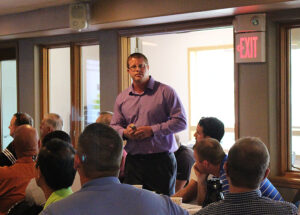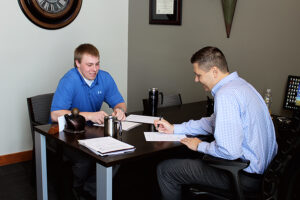2015 Recap: Evolving to meet customer needs
January 4, 2016Over the past several years, one might say the buzz word surrounding Heartland has been transition. From operations to leadership to customer programs–change has been a reoccurring theme. While 2015 was no exception, the transitions within Heartland echo a national and global energy landscape in flux due to increasing state and federal regulations, threats to security and rapidly changing market and usage trends. However, Heartland found over the past year that change comes with opportunity. As challenges present themselves, Heartland continues to grow, adapt and evolve in order to meet the needs of our customers and uphold our promise of exceptional customer service and reliable power supply.
SPP Integration
After years of preparation, functional control of the Integrated System (IS) was turned over to the Southwest Power Pool (SPP) on October 1. Joining a regional transmission organization proved to be the best possible scenario for the IS, ensuring efficient and reliable delivery of power by removing transmission barriers between buyers and sellers. SPP was found to be the most customer-friendly, least-cost option for IS owners Heartland, Western Area Power Administration’s Upper Great Plains Region and Basin Electric Power Cooperative.
The move was historic for Heartland, altering operations with a new and expanding workload. The most significant changes since beginning operation within SPP are how we operate our generation facilities and handle coordination with WAPA. Heartland also acquired additional duties on behalf of customers who receive WAPA allocations within both the SPP and Midcontinent Independent System Operator (MISO) markets. Although we are not required to physically perform scheduling for WAPA, we are responsible for creating forecasts and producing load schedules to be used by WAPA for their daily scheduling.
In order to succeed in today’s rapidly evolving industry, flexible planning and dynamic response to demands will be key. The SPP market will provide greater flexibility for buying and selling power as well as increase price transparency and efficiency.
Cybersecurity

The electric grid has served America well for more than 100 years, keeping our homes heated, our rooms lit and our computers running. It is a complex network of power plants, substations, transformers, wires, sensors and poles that carry electricity across miles of transmission lines to be distributed to homes, schools and offices. Information changes hands many times throughout the process of delivering electricity, and the smallest margin of error along the way provides an opportunity for a cyber attack.
Speaking at Heartland’s recent Winter Conference, WAPA CEO Mark Gabriel revealed that WAPA’s system has experienced hundreds of thousands of attacks annually from across the globe, including from within the United States. While the electric power sector and government partners continue to take steps to manage risks, utilities of all sizes must also be held accountable. Because everything is interconnected, the grid is only as strong as its weakest link.
With this in mind, Heartland partnered with Helix Security in 2015 to launch a new program to help customers protect their valuable data. Helix provides cybersecurity services in five phases, starting with the fundamentals and building towards a fully functioning security management package. Data protection such as this is vital for any utility, and with Heartland sharing in the cost, the program is very affordable and potentially one of the most important services we provide our customers.
Growing Customer Base
 Heartland continues to pursue new opportunities to expand our customer base and strengthen our company. In 2015 we announced the addition of Auburn, Iowa, a community of approximately 320 people located in West Central Iowa. Situated within the Midcontinent Independent System Operator (MISO), Auburn has a peak demand of 600 kilowatts. Our contract with the city is for ten years, during which time Heartland will supply all of Auburn’s wholesale power supply needs beyond their federal WAPA allocation as well as act as the scheduling agent for that allocation.
Heartland continues to pursue new opportunities to expand our customer base and strengthen our company. In 2015 we announced the addition of Auburn, Iowa, a community of approximately 320 people located in West Central Iowa. Situated within the Midcontinent Independent System Operator (MISO), Auburn has a peak demand of 600 kilowatts. Our contract with the city is for ten years, during which time Heartland will supply all of Auburn’s wholesale power supply needs beyond their federal WAPA allocation as well as act as the scheduling agent for that allocation.
Heartland began supplying power and electricity to Garden City, Kansas January 1. The Garden City commission approved a power supply contract with Heartland in June, agreeing to a supply of 15 megawatts for five years from Heartland resource Whelan Energy Center Unit 2 with the option to extend the contract for another five year term.
Situated within the SPP, Garden City’s electric department provides service to over 11,000 electric meters, maintains nine electric substations, 245 miles of overhead power line and 40 miles of underground power line throughout the city. This is Heartland’s first customer in Kansas, and Garden City’s proximity to WEC 2 as well as its location within SPP make it a perfect fit.
Customer Service and Advocacy
In 2015 we remained as dedicated as ever to our customers by finding new opportunities to provide assistance, additional funding, recognition and more.
- Enhanced customer service programs: Heartland boosted both our energy efficiency and economic development programs with the addition of new opportunities for customers, including new energy efficiency rebates for lifetime warranty electric water heaters, residential LED light bulbs and commercial refrigeration, as well as new assistance programs for communities concerning Certified Ready Sites and spec buildings.
-

Riley Bullington, left, worked with Director of Economic Development Ryan Brown, right, on the customer economic development research project in 2015. Economic development research: Riley Bullington, a Dakota State University college student, spent several months interning at Heartland completing a research project aimed at helping our customers with business retention and recruitment ventures. Bullington collected demographic information and key economic development data for each of our customer communities to help Heartland determine where and how to invest resources in order to make the most impact. The information will also be used when meeting with prospective businesses, community developers and site selectors.
- Distinguished Service Award: Heartland established the Distinguished Service Award in conjunction with Public Power Week, an annual opportunity for public power utilities to remind customers and stakeholders of the distinct advantages public power offers. It is designed to showcase public power utility employees in Heartland customer communities who are exceptional in service and who have made outstanding contributions to their municipality, community and other organizations. The inaugural recipient was Gary Horton, city administrator for the city of Akron, Iowa.
- PURPA assistance: Because small renewable energy projects are growing more popular with homeowners and business owners, Heartland has taken steps to ensure our customer utilities are in compliance with the Public Utility Regulatory Policies Act of 1978 (PURPA). Our assistance included filing a motion with the Federal Energy Regulatory Commission to define both Heartland’s and our customer utilities’ roles regarding PURPA as well as assisting with the creation of policies should a qualifying renewable project arise in one of our customer communities.
- Clean Power Plan: The Environmental Protection Agency published it’s final, controversial Clean Power Plan rule in the Federal Register October 23. That same day, a group of more than 20 states asked a federal court to strike it down, arguing the rule is “illegal and will have devastating impacts upon the states and their citizens.” Among the states challenging the rule were South Dakota, Nebraska, Kansas and Wyoming.
